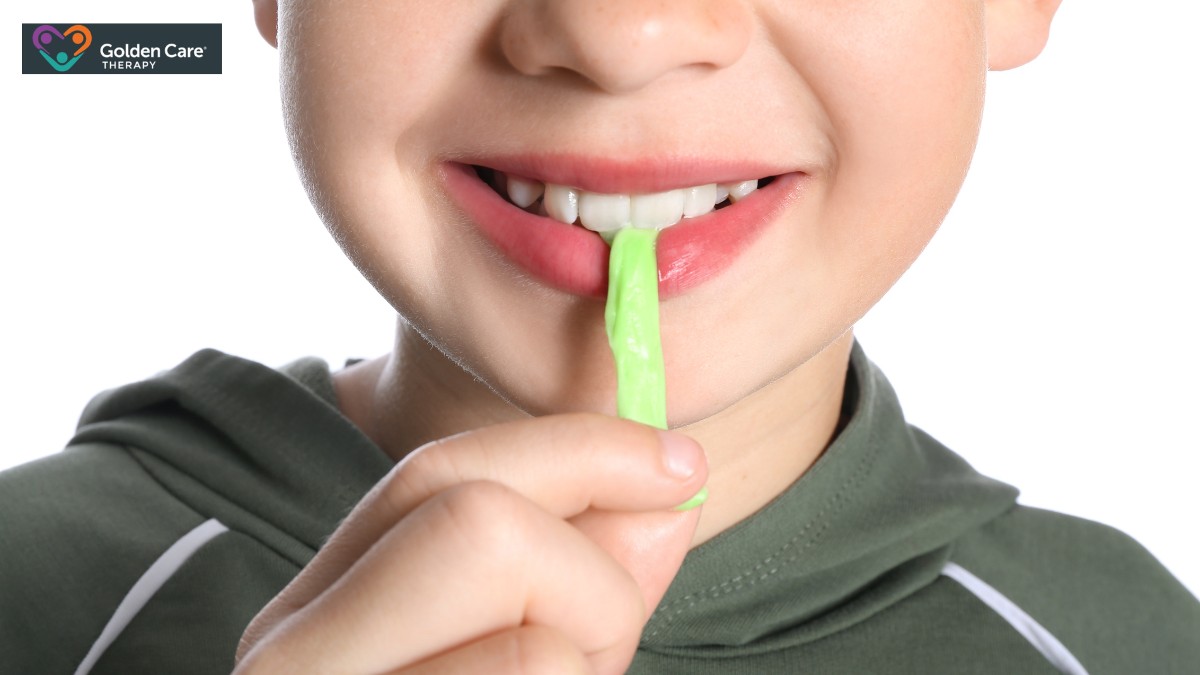Chewing gum might seem like a simple habit, but for many individuals with autism, it serves a unique purpose beyond just freshening breath. From calming nerves to providing sensory feedback, there’s more to this common activity than meets the eye. Additionally, it can help prevent overeating by providing a satisfying oral sensory experience that may reduce cravings.
But what exactly is the science behind it? Let’s dive into how chewing gum can play a meaningful role in the lives of people with autism, offering a surprising connection to sensory processing and emotional regulation.
The Science Behind Chewing Gum
Chewing gum is more than just a habit, as it also engages multiple sensory and physiological processes. The act of chewing stimulates the jaw muscles and activates sensory receptors in the mouth, providing both tactile and proprioceptive input.
Research shows that chewing activates areas of the brain associated with attention and memory. This is because the repetitive motion of chewing increases blood flow to the brain, enhancing cognitive function.
For autistic individuals, this can translate to improved focus and reduced distractions.
Oral stimulation provided by chewing gum can be particularly beneficial for those with oral sensory-seeking behaviors. These behaviors may include biting, chewing on objects, or mouthing non-food items. By offering a safe and socially acceptable outlet for oral stimulation, chewing gum can help satisfy sensory needs.
How Chewing Gum Supports Sensory Regulation
Sensory regulation is the ability to manage and respond appropriately to sensory stimuli. For individuals with autism, achieving sensory regulation can be challenging. Chewing gum offers a portable and discreet way to support this process.
Chewing gum has been shown to lower cortisol levels, the hormone associated with stress. For individuals with autism who experience heightened anxiety in social or overstimulating environments, chewing gum can serve as a calming mechanism.
Moreover, the rhythmic act of chewing helps filter out extraneous sensory input, allowing individuals to concentrate better. In classroom settings or therapy sessions, chewing gum can be a valuable tool for improving attention span and engagement.
Some individuals with autism have an intense need for oral input, often leading to behaviors like chewing on clothing or pencils. Chewing gum provides a safe alternative that satisfies this sensory craving, reducing the likelihood of engaging in less desirable behaviors.

Practical Applications of Chewing Gum for Autism
Incorporating chewing gum into daily routines can offer significant benefits for individuals with autism. However, its effectiveness depends on thoughtful implementation.
When selecting chewing gum, consider the following:
- Texture: Opt for gum that maintains its chewiness without disintegrating quickly.
- Flavor: Choose mild flavors to avoid overwhelming sensitive taste buds.
- Ingredients: Sugar-free options are ideal to prevent dental issues.
Also, safety is paramount when introducing chewing gum. To ensure a positive experience, make sure to keep these in mind:
- Supervision: Monitor usage, especially for younger children or those prone to swallowing gum.
- Education: Teach appropriate gum-chewing habits, such as not swallowing gum and discarding it properly.
- Timing: Use gum during activities that require focus or as a calming strategy in stressful situations.
Potential Challenges and Considerations
While chewing gum can offer numerous benefits, it’s essential to be aware of potential challenges.
Not all individuals with autism enjoy the sensation of chewing gum. Some may find the texture or flavor unpleasant. In such cases, alternative oral sensory tools, like chewable necklaces or toys, may be more appropriate.
For individuals with difficulties understanding the concept of chewing versus swallowing, gum may pose a choking hazard. Introducing gum requires careful consideration of the individual’s developmental level and safety awareness.
While chewing gum is generally socially acceptable, excessive chewing or inappropriate disposal can lead to negative perceptions. Teaching proper gum etiquette is crucial to avoid these issues.
If chewing gum isn’t suitable, there are other ways to address sensory and oral input needs. These alternatives include:

Although limited, research on the benefits of chewing gum for individuals with autism highlights its potential. Studies have shown improvements in attention, stress reduction, and oral sensory satisfaction, suggesting that chewing gum can be a valuable addition to sensory regulation strategies.
In practice, many caregivers and therapists report positive outcomes when incorporating chewing gum into interventions for individuals with autism. These anecdotal successes underscore the importance of individualized approaches.
Chewing gum can complement other therapeutic interventions for autism, such as Applied Behavior Analysis (ABA), speech therapy, and sensory integration therapy. By incorporating gum as a tool for sensory regulation, caregivers and professionals can enhance overall treatment outcomes.
The Bottom Line
Consulting with occupational therapists and speech-language pathologists ensures that chewing gum is used effectively and safely. These professionals can provide guidance on tailoring interventions to meet individual sensory needs.
Chewing gum is a simple yet powerful tool for supporting individuals with autism. From promoting focus to satisfying oral sensory needs, it offers a range of benefits that can improve daily functioning and quality of life.
However, its success depends on careful implementation, safety considerations, and individual preferences. At Golden Care Therapy, we are committed to providing personalized and effective ABA therapy that caters to the unique needs of every individual. Our expert team is dedicated to helping you achieve lasting progress in a supportive environment.
We proudly offer autism services in New York, New Jersey, Indiana, Georgia, and Florida, ensuring that families across these states have access to high-quality care. Reach out to us today to learn more about how we can assist you on your journey!



